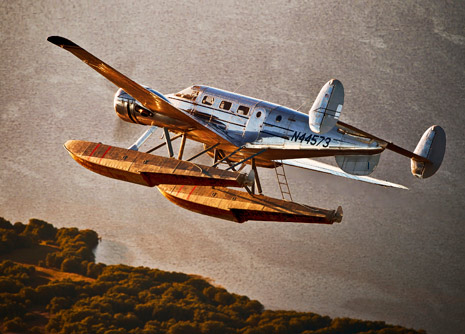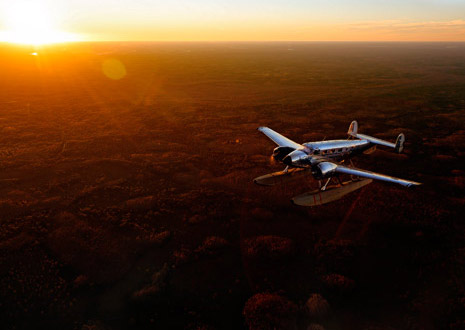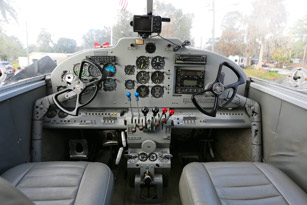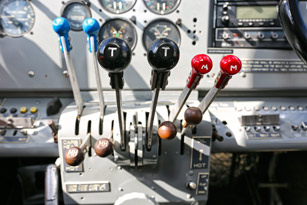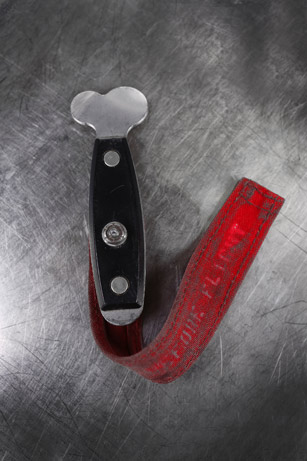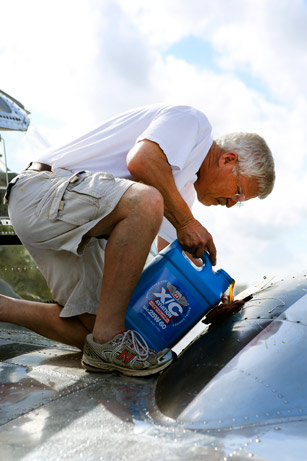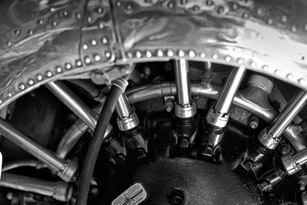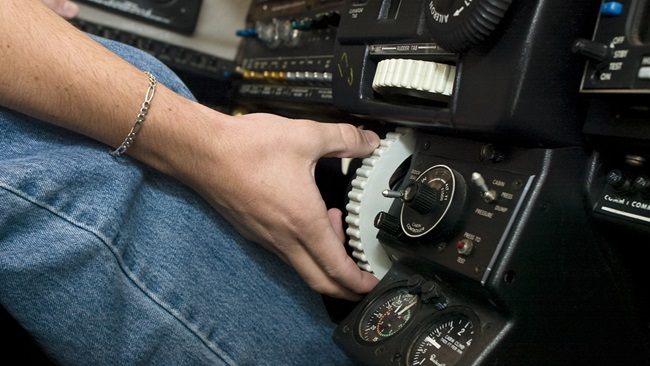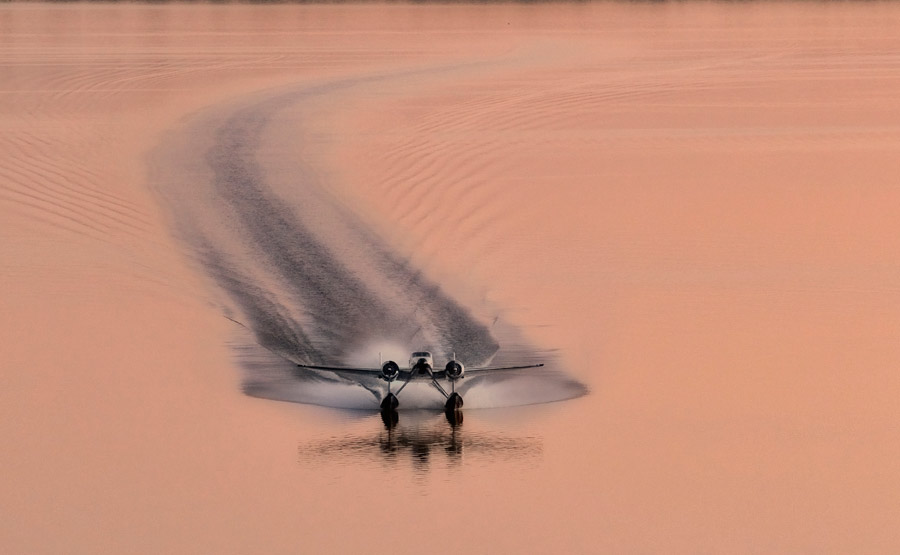
The last of the 1.5 gallons of oil chugs into the left engine’s tank, satisfying the big Pratt & Whitney R-985—for now. Meanwhile, grunts on each of the Beech’s massive straight floats furiously work hand pumps, sucking gallons of lake water from leaky compartments. Over on the right wing, a pilot curious to experience flight in a Beech 18 earns his keep by pouring avgas from five-gallon jugs into the softball-sized filler port.
Readying this 70-year-old girl for a three-day trip from Minnesota to Florida seems more akin to launching a cruise ship. The Twin Beech is one of five seaplanes migrating from the Minneapolis area to Central Florida for the winter—where they will continue working, teaching pilots to fly on floats and hosting flightseers.
The work pays off, though, when—like an old dog shaking off the cold, the 450-horsepower engines shudder to life. Lines are tossed from the dock into the open cabin door while a slow taxi allows the oil temperature to eventually reach the required 40 degrees Celsius on this crisp fall morning.
“Do this by yourself and it takes an hour or more,” says Mark Baker as he guides the rumbling airplane to a clear path on the lake. Although the AOPA president has owned N44573 only since last summer, he’s been around seaplanes and round engines most of his adult life. To him, the Beech 18 is the epitome of floatplane flying—a beautiful old radial-engine airplane on straight floats, challenging to operate and a delight to fly; just being a part of the magical history of such a beast is more than enough reward for enthusiasts.
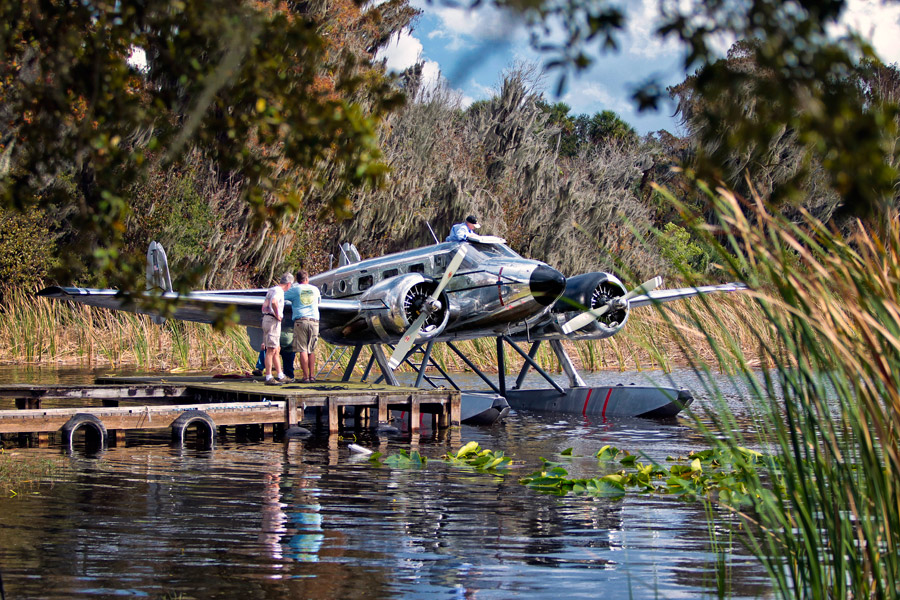
Mashing those two throttles forward creates an overwhelming din that not even top-of-the line active noise-canceling headset can repel. The cacophony reverberates through your very being. Haul back on the yoke and the big girl claws her way up; relax the pressure to get on the step, spray going everywhere; then away you go, lumbering upward at a stately pace. The lake falls away and you suddenly realize you’re flying a Beech. The comforting control harmony you’ve come to expect is there—heavier than in a Baron, but you know the feeling. Level off at a couple of thousand feet, close the cowl flaps, tune up the propellers, set the mixture, adjust the carb heat as needed, and finesse the oil shutters (if you like dinking with levers in the cockpit, you’ll love the Beech 18). With the draggy floats hanging out, the 18 doesn’t so much fly as it sashays though the air. It’s like riding in an old Buick. Yank the power off and look straight down for your landing spot. You’ll need to add power just to maintain blue line (best single-engine rate of climb speed) during steep turns.
With 223 gallons of fuel on board (fore and aft tanks in each wing and a common nose tank), you’d think you could cruise a long distance—but did I mention all that drag? On straight floats you don’t pass up many fueling opportunities, because finding suitable water with docks and fuel available is a challenge in many parts of the country. At a leisurely 1,875 rpm on the two-blade props and 24 inches of manifold pressure, count on about 110 knots at most lower altitudes while burning 20 gallons per side. If you’re in a hurry, you’re in the wrong airplane.
Stepping back in time
My first landing is on day two of the migration, on Kentucky Lake. We swing wide over the lake and turn into the wind and toward the marina where we can get fuel. With plenty of open water, I allow the Twin Beech to get into “ground” effect and then, with partial flaps, set up a shallow descent while nudging the throttles back. With Baker’s coaching, I haul back on the big yoke and the old floats skim, then plunge into the water. I add power for the long step taxi to the docks. An experienced pilot could have slipped the big twin in much closer, but we aren’t taking any chances. At the dock, a pilot from one of the other airplanes thankfully is there to assist. We chug toward a dock on the end with lots of open space around. Baker shuts the engines down 30 feet out and we coast in, a passenger tossing a line to the dock. Then, the hauling of gas cans, sumping of floats, and schlepping of oil starts all over again. It’s like stepping back in time.
Like its counterparts built between 1937 and 1969, this Beech C18S has history in spades. Rolled out of the Beechcraft factory on wheels, it was delivered to Sinclair Prairie Oil Company on September 16, 1944. It was among a block of 40 Beech 18s released by the federal government for civilian use during World War II. While hundreds of other Beech 18s soldiered in the war effort as C–45s, NC44573 was set on a business mission to, among other things, spur oil exploration. In his comprehensive book Beech 18: A Civil & Military History, Robert K. Parmerter calls the group “the most significant 40 airplanes that Beech ever produced. The companies that bought them in 1944 were among the most important and influential in America.” These companies discovered the value of business transportation. They and other companies after the war continued to gobble up similar new and surplus airplanes, building the corporate aviation infrastructure still in use today. The Beech 18 was so popular in this role that Parmerter reports that 70 percent of the companies on the 1955 Fortune 500 list owned or would own one. N44573 is the only remaining flying example from that august group.
But the model almost didn’t make it into production. Thriving off the brisk sales of Beech 17 Staggerwings, the company had never built a metal or twin-engine airplane when the Bureau of Air Commerce in August 1935 put out a request for bids on a twin. While meant to satisfy its own need to move airline inspectors around, most believe the bureau really meant to spur development of a mid-sized twin at a time when your choice was either a four- or five-place single or a 10- to 14-seat multiengine airliner. Company founder Walter Beech weighed the risk of investing in such a radically different product. Ethyl Gasoline Corporation quickly ordered one based only on Beech’s basic design work. A customer survey revealed a market for an eight-place twin with the right combination of speed, range, comfort, and economics.
By the time he green-lighted the project only 10 months remained to build one to meet the bureau deadline of July 1, 1936. Chief Engineer Ted Wells designed the structure using metal tubing because “that’s what I knew best,” he told Parmerter years later. The twin tails emerged because Wells and Walter Beech had seen success together earlier working on the design of the twin-tail Curtiss Robertson Kingbird D–2.
Despite Herculean efforts, the small company could not complete the design in time to meet the bureau’s mandate. Mammoth Lockheed was the only one of the three finalists (Barkley-Grow rounded out the trio) to fly a model ahead of the deadline. The bureau ordered one of the new Lockheed Model 12s, a scaled- down version of the Model 10. But shrewd Walter Beech had not bet the company on the government contract. Instead he had first and foremost built an airplane his retail customers wanted. First flight of the prototype occurred on January 3, 1937, with delivery of that prototype occurring on June 25 that same year to Ethyl Gasoline for the price of $32,439. Over the 30-year production run, nearly 10,000 Beech 18s would be built, accounting for one third of all Beeches when production ceased in 1969.
Parmerter describes the Beech 18 as the most modified aircraft of all time. In his 567-page book he details dozens of models and military variations performing hundreds of different missions. Beech 18s trained bomber pilots; paved the way for launching guided missiles and remotely piloted aircraft; carried airline passengers, fish spotters, parachutists, and movie stars; and even picked up and delivered mail without landing. Variants included tricycle landing gear, a tri-tail, turboprop engines, fuselage stretches, skis, floats, and spray bars.
Great rewards
Our polished example flew as a tailwheel airplane for its first three decades before an owner in 1974 beefed up the fuselage and installed a set of Edo 56-7850A straight floats. Nearly 25 years later, another owner added the much-needed ladder on the starboard side to ease access to the floats, the wraparound windshield, and float hatches. The cavernous hatches easily accommodate a passel of five-gallon fuel cans, a necessity when flying a draggy airplane on straight floats in regions with few fueling options. During our three-day floatplane migration we frequently hauled out jugs, schlepping them up the left wing and over the cabin to the waiting fueler. Even getting to the right side of the airplane can be a challenge, because the cabin doors are on the left. You first pop the hatch open above the cockpit, stand on the pilot seats, and hoist your derriére up onto the top. Lean back to get your legs out and then slide down the right side onto the wing to service the engine and fuel tanks.
Now imagine five middle-aged men with middle-aged waist sizes all performing these feats multiple times a day.
Oh, and don’t forget the starboard floats. For that you’ll continue aft on the wing to that welcome starboard ladder to climb down to the float, being careful not to slip because there is deep, cold water down there. Hunker down onto your knees (knee pads are on every such pilot’s Christmas list), and squirm your way forward to both check the gascolator and the two underwing sumps on that side and to sump the four float compartments. Whatever pants, shirts, and shoes you’re wearing by now have been baptized with oil. You know the saying about radial engines and oil? If it’s not leaking, it’s empty. Now, scamper back up the ladder, hoist yourself onto the roof, through the hatch, and slide your oily self back onto the seat.
As Baker notes, you’re not really a floatplane pilot until you’ve fallen in at least once and separately dropped something expensive (e.g. prescription sunglasses or smartphones) into the water.
To quote President Kennedy, we choose to do these things “not because they are easy, but because they are hard.” And things that are hard often have great rewards—and such is the case when flying a Beech 18 on floats.
Take off and land at remote places inaccessible to most everyone else. From just above lakes, and rivers, the world scrolls past at a comprehensible pace. As we meander down the Mississippi River, we see how the country developed with the railroads and highways paralleling the rivers; bridges stitching it all together. This is a multimodal transportation system at its most basic—and without necessity of twenty-first century urban planners. We have the time to contemplate the historic route and admire the small towns with their tree-lined streets.
From our perch, it’s almost like the airplane’s 70 years have melted away. The factories below might well be spooling up to build jeeps and tanks for the war. Or perhaps it’s a decade later during the booming 1950s; or later, the dramatic 1960s, the confused 1970s, the self-righteous 1980s, or beyond. Our ride has seen it all and still flies on, the polished skin reflecting the times as they unfold. Flying such an historic and capable airplane, you get the sense that you’re just along for the ride, a passing guest in this gleaming time machine that will be plying the skies for many decades to come. As they say about these antiques, we’re just today’s keepers of the world’s classics—a list the Beech 18 tops.
Video: Fly along with the author in this online video.
Email [email protected]
Photography by Chris Rose
